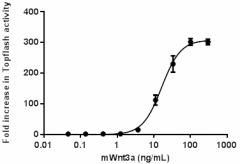- Regulatory Status
- RUO
- Other Names
- wingless-type MMTV integration site family, member 3A, Wnt-3a, vt

-

Mouse Wnt3a induces Topflash reporter activity in HEK293T human embryonic kidney cells with ED50 range of 7 - 35 ng/mL. -

Stability testing for mouse Wnt3a. An aliquot of mouse Wnt3a was kept at 4°C for one month and compared to a control kept at -20°C (control). The samples were tested in Topflash reporter assay.
| Cat # | Size | Price | Quantity Check Availability | ||
|---|---|---|---|---|---|
| 772301 | 2 µg | $159.00 | |||
| 772302 | 10 µg | $464.00 | |||
Select size of product is eligible for a 40% discount! Promotion valid until December 31, 2024. Exclusions apply. To view full promotion terms and conditions or to contact your local BioLegend representative to receive a quote, visit our webpage.
Wnt-3a belongs to Wnt family of proteins that consist of structurally related genes encoding highly conserved cysteine rich secreted glycoproteins. Wnt family proteins have been implicated in oncogenesis and in multiple developmental processes including regulation of cell fate and patterning during embryogenesis. Wnts are ligand for seven-pass transmembrane receptors of the frizzled family. Wnts bind Frizzled receptors and forms complex with low-density lipoprotein receptor-related protein (LRP5 or LRP6) which results in the stabilization of intracellular beta-catenin levels. Intracellular accumulation of beta-catenin increases translocation of the protein into the nucleus, where it binds to TCF/LEF transcription factors to promote expression of Wnt target genes. Lack of Wnt signaling disrupts transcriptional activation of tumor suppressor genes, and has been shown to result in neoplastic transformation, oncogenesis, and human degenerative disease. Wnt-3a is a highly conserved lipid-modified, secreted hydrophobic glycoprotein with conserved 24 cysteine residues that is essential for cell signaling. Wnt-3a is required for normal embryonic mesoderm development and formation of caudal somites. It is also required for normal morphogenesis of the developing neural tube. Wnt-3a mediates self-renewal of the stem cells at the bottom on intestinal crypts.
Product Details
- Source
- Mouse Wnt-3a, amino acids Ser19-Lys352 (Accession # P27467) was expressed in CHO cells.
- Molecular Mass
- The 334 amino acid recombinant protein has a predicted molecular mass of approximately 37.4 kD. The DTT-reduced protein migrates at approximately 41 kD. The predicted N-terminal amino acid is Ser.
- Purity
- > 75%, as determined by Coomassie stained SDS-PAGE under reducing conditions.
- Formulation
- 0.22 µm filtered protein solution is in PBS, pH 7.4 - 7.6, 1% CHAPS, 0.1% BSA.
- Endotoxin Level
- Less than 0.1 EU per µg protein as determined by the LAL method.
- Concentration
- 2 and 10 µg sizes are bottled at 0.05 mg/mL.
- Storage & Handling
- Unopened vial can be stored at -20°C to -70°C for six months. For maximum results, quick spin vial prior to opening. The protein can be aliquoted and stored at -20°C to -70°C. Avoid repeated freeze/thaw cycles.
- Activity
- Measured by its ability to induce Topflash reporter activity in HEK293T human embryonic kidney cells. ED50 for this effect is 7 - 35 ng/mL.
- Application
-
Bioassay
Antigen Details
- Distribution
-
Dorsal portion of the neural tube (developing roof plate), and mesenchyme tissue surrounding the umbilical vein.
- Function
- Required for normal embryonic mesoderm development and formation of caudal somites. Required for normal morphogenesis of the developing neural tube.
- Interaction
- Stem cells
- Ligand/Receptor
- Frizzled receptors, LRP5/6
- Bioactivity
- Measured by its ability to induce Topflash reporter activity in HEK293T human embryonic kidney cells.
- Cell Type
- Neural Stem Cells, Mesenchymal Stem Cells, Embryonic Stem Cells
- Biology Area
- Stem Cells
- Molecular Family
- Growth Factors, Cytokines/Chemokines
- Antigen References
-
- Takada S, et al. 1994. Genes Dev. 8:174-89.
- Korinek V, et al. 1997. Science. 275:1784-7.
- Ikeya M, Takada S. 1998. Development. 125:4969-76.
- Gunhaga L, et al. 2003. Nat. Neurosci. 6:701-7.
- DasGupta R, et al. 2005. Science. 308:826-33.
- Jamora C, et al. 2003. Nature. 422:317-22.
- Nordstrom U, et al. 2002. Nat. Neurosci. 5:525-32.
- Reya T, et al. 2003. Nature. 423:409-14.
- Ten Berge D et al. 2011. Nat. Cell. Biol. 13:1070-5.
- Gene ID
- 22416 View all products for this Gene ID
- UniProt
- View information about Wnt3a on UniProt.org
